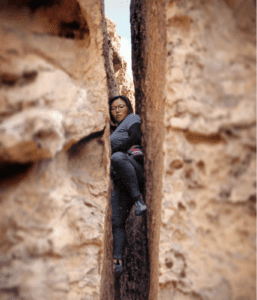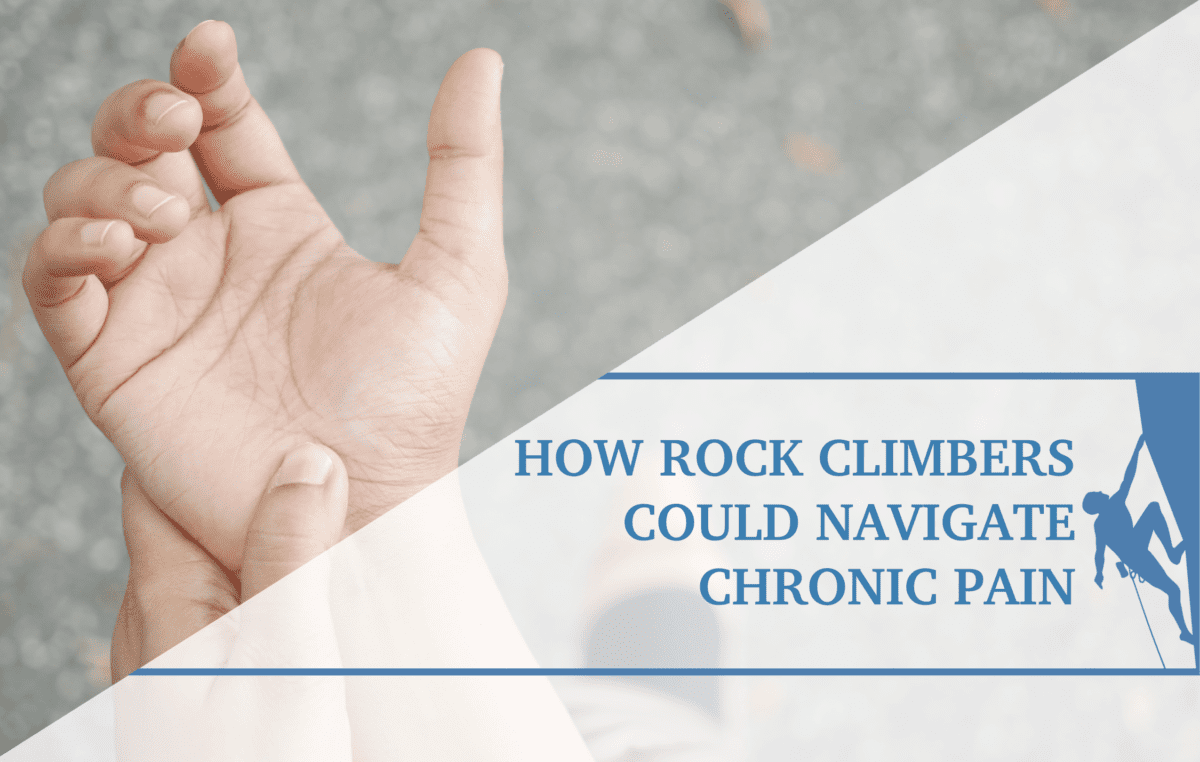Considerations for Adaptive Climbing
Although not often thought about, major amputations may occur from any outdoor recreational activities such as rock climbing. With any sport, there are risks; however, with rock climbing, a single mistake, or even being at the wrong place at the wrong time, may cost one’s limb. Whether it be from a traumatic accident, frostbite, gangrene, or from a rockfall, experiencing an amputation is often horrifying. Moreover, climbing alone forms a very small percentage of amputations for paraclimbers. There may be other causes such as congenital amputation, osteosarcoma, a motor vehicle accident, peripheral vascular disease, diabetes, and so on, that could potentially lead to limb loss. Amputations may affect both daily and recreational activities. Following an amputation, there are major challenges returning to rock climbing because there are many more factors to consider. It is important to consider those with amputations with there being more than 2 million people living with limb loss in the United States alone.
This article will take you through essential prosthetic considerations for various types of climbing, with insights into how climbers with amputations adapt to different climbing styles. We’ll explore how prosthetics are used in mountaineering, traditional climbing, sport climbing, and bouldering, highlighting the challenges and solutions for both upper and lower limb amputees. Additionally, you’ll gain an understanding of the specific prosthetic technologies available and how these athletes overcome obstacles to continue climbing with remarkable skill and determination.
Prosthetic Considerations for Different Types of Climbing
Before proceeding into this section, it is important to understand that climbers with amputations do not have the ability to utilize sensory feedback when rock climbing with their prosthetic limb(s). Therefore, climbers will most likely have to use their vision more to climb than they would their sensation. Since climbing is largely based on proprioception and sensation, prosthetics are not the perfect option by any circumstance. They would only be used in situations where the climber requires the prosthetic to perform a specific move as part of a route. Otherwise, most climbers would opt to go without prosthetics. Furthermore, the more proximal their amputations are, the more difficult it is for the climber to properly utilize their prosthetics due to the fact that there is more than one joint the climber is lacking.
MOUNTAINEERING/ALPINE CLIMBING
Mountaineering or alpinism is loosely defined as ascending mountains. This can involve rock climbing, snow and ice climbing, and glacier traveling, all with heavy packs. This can be extremely challenging for paraclimbers, but by no means impossible.
In the 1940’s, Jim Gorin became the first known amputee climber, and was influential in that he was living evidence that it is possible to be a mountaineer with just one leg and two crutches. However, for more technical terrain, this could be incredibly challenging. After losing both his legs due to frostbite in 1982 as a 17-year old, Hugh Herr created his own prosthetic limbs to allow him to climb on par with elite level climbers. As a result, he was able to switch his feet for each technical terrain. Moreover, since he has created the world’s first bionic ankle, he has provided the ability for athletes to hike more comfortably.
When it comes to ice-climbing, crampon feet are also now available to make it possible for one to ice-climb. As for those with upper extremity amputations, ice axe prosthetics may make it possible for an adaptive climber to safely ice climb.
The main consideration would be that the climber would have to carry all of their prosthetic parts in addition to the heavy sack that they are already carrying.
TRADITIONAL CLIMBING
Trad climbing is a form of free climbing in that it requires the climber to use their hands and feet to find holds on the rock to ascend, as opposed to aid climbing, which means that an aiding device like a ladder is used to pull oneself up. The climber utilizes safety gear such as rope and harness to prevent one from falling to the ground. In trad climbing, the climber uses removable hardware, both active and passive, into cracks in the rock as protection to prevent the climber from falling to their deaths.
Although climbing the rock face is still an integral part of traditional climbing, the most important part of trad climbing would be crack climbing. When climbing a single pitch trad-route with very thin cracks, the climber would use a prosthetic foot such as the “hatchet foot” made by Hugh Herr. For upper limb amputation, the climber could simply use their stump to jam into a crack. For multi-pitch climbing, the climber may need to carry different prosthetics for different rock features, switching their limb at the anchors. The prosthetics for face climbing will be listed below in the sport climbing section.
SPORT CLIMBING
Sport climbing is also a form of free climbing; however, instead of using removable hardware to protect oneself from fatal falls, the climber would utilize quickdraws to climb rock faces with pre-placed bolts.
Since sport climbing typically consists of face climbing, those with lower limb amputations may use a basic foot prosthetic with climbing shoes such as Evolv’s El Dorado Z-Axis Foot. There are also better options such as the ADK rock climbing foot by Mountain Orthotic and Prosthetic Services. And if one has the expenses, the Kai Lin Leg, inspired by observing mountain goats, can be useful for climbing. For those with transfemoral amputations, it can be difficult to use prosthetics for certain types of movements. To illustrate, a specific rock climbing prosthetic (RCP) for above knee amputations (AKA) addresses the problems many with AKA experience when climbing. The RCP allows the climber to put weight on the medial border of their shoe by using a thigh rotation system and the knee unit allows the climber to fully flex their knee and hyperextend their knee by five degrees for extra standing stability. Moreover, the use of titanium makes the prosthetic much lighter.
As for those with upper limb amputations, the climber could use a prosthetic such as the Raptor Sky Hook for crimpy problems. However, with any paraclimber, using a prosthetic limb is not always required. Jim Gorin successfully climbed with just one foot and Maureen Beck, born without her left lower arm, is a phenomenal rock climber who simply climbs with her stump.
TOP ROPING
Top roping is a form of rock climbing where the climber is attached to a rope that runs through a fixed anchor at the top of the route, and back down to the belayer at the base of the climb. The considerations for prosthetics are like that of any other forms of free climbing. Top roping can be done on both sport and trad climbing routes, which means that the climber would need to do adequate research to determine which prosthetic limb, if any, they’d like to bring with them.
FREE SOLOING
Free soloing is a form of climbing where the climber has absolutely no protective equipment. The climber takes off with just their climbing shoes and a chalk bag. If they were to fall while climbing, they would fall straight to the ground, potentially risking death.
For one’s safety, free soloing is never recommended; however, if one wants to free solo as a paraclimber, they’ll find a way to do it. Since it is highly unlikely that the climber would have the opportunity to change their prosthetic for different parts of the climb as they would like, it would be imperative for the climber to know the route extremely well and to choose their prosthetic limb carefully. On the other hand, for climbers who do not climb with prosthetics, the prosthetic consideration would not apply.
BOULDERING
Bouldering is similar to free-soloing in that the climber doesn’t use any rope or protective gear while climbing; however, because every fall is a ground fall, climbers do have available a crash pad to soften and protect their landings. Bouldering routes, or “problems,” are typically short and very technical or powerful.
Due to the nature of bouldering, and how much more likely the climber would require a more crouched position, a climber with a lower limb prosthetic may have a difficult time using their artificial limb. Especially as the amputation is higher up on the leg, the prosthetic limb may not bend at the knees, which could potentially make it difficult to boulder. Some climbers would consequently opt to climb without their prosthetics. However, if the climber has access to more funds, they may be able to obtain the RCP mentioned in the sport climbing section.
The Rock Rehab Pyramid
For each amputation region below, we will be utilizing categories from the Rock Rehab Pyramid developed by Dr. Jared Vagy in his book Climb Injury-Free. The rock rehab pyramid allows climbers to self-gauge injury and load and gives guidance of targeting tissues by an unloading phase moving to mobility, followed by strength and lastly the movement phase.
UPPER LIMB AMPUTATION
Below the Elbow (Transradial): Amputations occurring anywhere along the forearm.
Unload exercises:
- Mirror therapy
- Lacrosse ball SMR
Mobility exercises:
- Elbow flexion/extension ROM and stretching (biceps + triceps)
- Shoulder flexion/extension ROM
- Shoulder internal and external rotation ROM
- Pec Stretch
- Scapular mobility ROM
Strength exercises:
- Scapular strengthening (mid + lower trap squeezes)
- Supermans
- Bird-Dogs (with prosthesis)
- Dead Bugs
- Banded chest flyes
Movement exercises:
- Donning and doffing of prosthetic
- Opening/closing doors
- Picking things up and putting things down with prosthetic
- Learning how to put on/take off clothes (buttons, zippers, etc.)
- Using kitchen appliances
Above the Elbow (transhumeral): Amputation anywhere along the upper arm.
Unload exercises:
- Mirror therapy
- Lacrosse ball SMR
Mobility exercises:
- Shoulder flexion/extension ROM
- Shoulder IR/ER ROM
- Shoulder horizontal abduction/adduction ROM
- Pec stretch
- Scapular mobility ROM
Strength exercises:
- Scapular strengthening (mid + lower trap squeezes)
- Supermans
- Bird-Dogs (with prosthesis)
- Dead Bugs
- Banded chest flyes
Movement exercises:
- Donning and doffing of prosthetic
- Opening/closing doors
- Picking things up and putting things down with prosthetic
- Learning how to put on/take off clothes (buttons, zippers, etc.)
- Using kitchen appliances
LOWER LIMB AMPUTATION
Below the Knee (transtibial): Amputation occurring anywhere along the lower leg.
Unload exercises:
- Mirror therapy
- Foam roll (hips, quad, hamstrings)
Mobility exercises:
- Knee flexion ROM
- Hip flexion ROM
- Hip flexor + quad stretch
- Hamstring stretch
- QL stretch
Strength exercises:
- Quad set
- LAQ
- Hip abduction
- Dead bugs
- Glute bridge
Movement exercises:
- Gait (walking + jogging)
- Walking up and downstairs (progress to high step ups)
- Step over obstacles
- Squatting (zercher/goblet squat)
- Hinging (RDL – SL + DL)
Above the Knee (transfemoral): Amputation occurring anywhere along the thigh.
Unload exercises
- Mirror therapy
- Lacrosse Ball SMR
Mobility exercises
- Hip flexion ROM
- Hip flexor stretch (extension)
- Hip adduction ROM
- Hip internal rotation ROM
- QL stretch
Strength exercises
- Hip abduction and adduction
- Hip extension (reverse hypers)
- Dead Bugs
- Wood choppers
- Supermans
Movement exercises
- Gait (walking + jogging)
- Walking up and downstairs (progress to high step ups)
- Step over obstacles
- Squatting (box squat)
- Hinging (RDL – SL + DL)
The Research
- https://www.commonclimber.com/leg-prosthesis.html
- Awareness, potential factors, and post-amputation care of stump flexion contractures among transtibial amputees
- Physiopedia (knee flexion contractures)
- Raptor Sky Hook
- ADK Rock Climbing Foot
- Evolv El Dorado Z Foot
- Maureen Beck
- The Importance of Rehab Following Upper Extremity Amputation
- An Above-Knee Prosthesis for Rock Climbing
- Gullhane LE amputee rehab protocol
See a Doctor of Physical Therapy
For anyone who is experiencing an amputation, it is crucial to see a physical therapist who has had experience working with other patients with amputations for a proper rehabilitation program. It is also essential that this therapist is working with other healthcare professionals to ensure the best quality care. Navigating the complications that may arise from an amputation is extremely difficult and should not be done by oneself alone. A therapist will be able to provide those with amputations effective programs to ensure they are at least able to perform activities of daily living while ensuring safety. The therapist will be able to help the patient maintain the mobility essential for prosthetic use, as well as the strength to perform daily tasks. Minimizing fall risk, learning how to properly use and take care of prosthetics, and gaining independence can significantly improve one’s quality of life.
Author Bio

My name is Lucy Kim and I am a physical therapy student at the University of Nevada, Las Vegas. I was born in Korea and grew up in Singapore before moving to the states for my undergraduate studies. I fell in love with climbing in 2019 and traveled to many climbing destinations for the next two years. However, on March 7, 2021, I almost lost my foot from an open ankle dislocation following a freak bouldering accident. I barely made it to the hospital in two hours, and remember wondering if my foot would survive this ordeal. I was fortunate to have kept my foot. Regardless, due to my excruciating slow rehabilitation and recovery process, I often found myself thinking about whether an amputation would have been a better option. Following this experience, I have been a lot more interested in the world of paraclimbers.
Feel free to connect with me on Instagram, @lucyclimbs.
- Disclaimer – The content here is designed for information & education purposes only and the content is not intended for medical advice.




